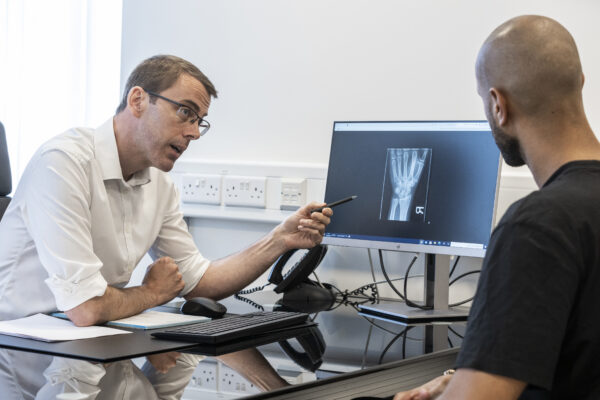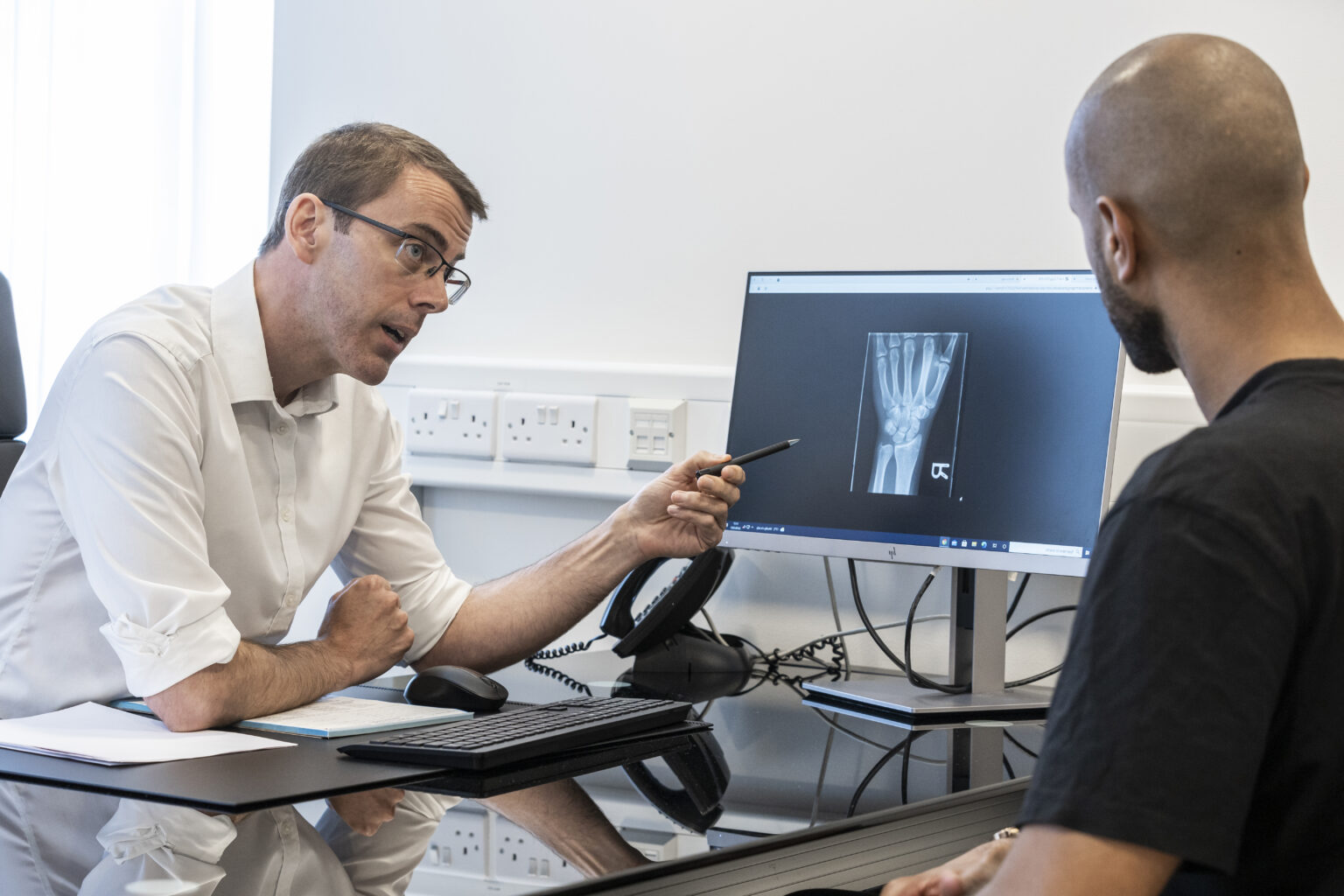Contact number: 020 7806 4060
What is trigger finger?
Trigger finger happens when a tendon, or the tunnel the tendon runs through, becomes swollen and inflamed. This causes the tendon to catch or jam and make it difficult to bend the affected finger or thumb. It can also cause stiffness and pain.
What is Trigger Finger Release Surgery?
Trigger finger release surgery involves dividing the sheath around the affected tendon to relieve pressure and allow the tendon to glide freely. This procedure is performed under local anaesthesia and is minimally invasive, usually requiring only a small incision.
Trigger finger surgery is typically recommended for patients with severe or persistent symptoms that have not responded to non-surgical treatments like splinting, steroid injections, or physiotherapy.
Located in St John’s Wood (NW8), our hospital offers advanced facilities and compassionate care for patients undergoing trigger finger release surgery.
Trigger Finger Release Surgery at St John & St Elizabeth Hospital
At St John & St Elizabeth Hospital, we provide trigger finger release surgery as part of our comprehensive hand surgery services. Our experienced consultants tailor each treatment to the patient’s individual needs, ensuring effective outcomes and a smooth recovery.
Why choose us for trigger finger release surgery?
- Specialist Hand Surgeons: Our consultants are experts in treating hand and finger conditions with precision and care.
- Minimally Invasive Techniques: Small incisions reduce scarring and promote faster healing.
- Modern Facilities: Our hospital is equipped with advanced surgical tools for effective and safe procedures.
- Accessible Location: Conveniently based in NW8, we serve patients from Hampstead (NW3), Kilburn (NW6), and across London.
We are dedicated to helping you regain full use of your hand through expert and compassionate care.
Consultants
Hospital Fee Guaranteed
£1,885
Trigger Finger Release costs £1,885 at St John & St Elizabeth Hospital.
The price shown includes all costs associated with your treatment, from admission to discharge, but doesn’t include surgeon or anaesthetist fee.
Hospital Fee Guaranteed: Our hospital fee is guaranteed at the price quoted and valid for one month from the date issued, subject to pre-assessment.
How to pay for your treatment
If you’re… paying for yourself
Did you know you don’t need private medical insurance to come to St John & St Elizabeth Hospital? As a self-pay patient, you can access safe, outstanding quality health care at times to suit you.
For scans and tests, as well as to see most consultants, you’ll still need to be referred by a medical professional like your GP, but as a self-pay patient, the process is more straightforward. You won’t need authorisation from an insurance provider, and you’ll have greater choice of consultant and appointment times.
If you’re… insured
St John & St Elizabeth Hospital is approved by all major medical insurance companies. If you have a personal private health insurance policy, or your company provide it for you, you can use it to pay for your care from your initial consultation through to treatment, surgery and aftercare such as physiotherapy. Not all private health insurance plans cover the same things. It’s very important to check exactly what you are covered for with your insurance provider.
Frequently Asked Questions About Trigger Finger Release Surgery
St John & St Elizabeth Hospital is located in St John’s Wood (NW8), a well-connected area of North West London. We are conveniently accessible for patients from Hampstead (NW3), Kilburn (NW6), and beyond.
By Tube:
- St John’s Wood station (Jubilee Line) is just a 5-minute walk from the hospital.
- Finchley Road (NW3) and Kilburn stations (NW6) on the Jubilee Line provide excellent connections.
- By Bus:
Wellington Road: Routes 13, 46, 82, and 113 stop near St John’s Wood Underground Station, just a short walk from the hospital.
Circus Road: Routes 46 and 187 stop close to the hospital’s Circus Road entrance.
Abbey Road: Routes 139 and 189 stop near the junction where Grove End Road becomes Abbey Road, providing easy access.
Major Roads:
If you’re travelling from NW3 or NW6, major routes such as Finchley Road or Kilburn High Road offer a direct approach to the hospital.
Our hospital ensures convenient access for patients across London, particularly those in NW8, NW3, and NW6 postcodes.
The symptoms of trigger finger are:
- Pain in the palm of your hand or at the base of the affected finger or thumb
- Stiffness or clicking when you move your finger or thumb, particularly first thing in the morning
- A lump in your palm
- Your finger may lock in a bent position, which means you have to stretch or pull it straight. This can be very painful. Eventually, it may not fully bend or straighten.
- Pain when gripping things such as when you’re cooking, opening a door or playing sport.
The exact reason why trigger finger happens isn’t known. However, it is more common in women, people over 40, and people who have diabetes or rheumatoid arthritis.
The treatment for trigger finger depends on the severity of your symptoms and how long you’ve had them. There are several treatment options, which include:
- Resting your hand and avoiding heavy gripping exercises
- Taking anti-inflammatory drugs, such as aspirin or ibuprofen, to help relieve pain
- Wearing a splint, particularly at night, to help keep your finger straight and prevent it from locking in the morning
- A corticosteroid injection – If you find your symptoms don’t settle, we would recommend a corticosteroid injection into the base of the finger or thumb. This settles symptoms completely in around 70% of cases. This can be done during a consultation with one of our Hand & Wrist doctors and only takes a few minutes. You can then carry on with your day as normal.
Trigger finger release surgery typically takes 15 to 30 minutes, depending on the severity of the condition and the number of fingers being treated.
Trigger finger surgery is a simple day case operation, which means you can be treated and go home the same day. It is usually performed with local anaesthetic, so you will be awake but have no sensation in your hand. Your surgeon will make the operation as safe as possible but complications can happen. These will have been discussed with you during your consultation. You should ask your doctor if there is anything you do not understand.
The surgery is performed under local anaesthesia, ensuring it is pain-free. Some mild soreness or swelling may occur afterwards but usually resolves within a few days.
Recovery from trigger finger release surgery is usually quick, with most patients resuming light activities within a week. Full recovery, including a return to heavy hand use, typically takes three to four weeks.
If you have a desk job or a job that involves manual labour: be careful when using your hand for the first two weeks. Light everyday activities should be okay but no heavy lifting for two weeks after surgery. If you have a desk job, you should be able to return to work straight away. If your job involves manual labour, you may need to take 4 weeks off.
Driving should be avoided for at least the first 3-5 days after surgery. Take advice from your doctor on return to driving, and only do so when you feel you are safe.
People who play sports may need to avoid heavy exercises for the first ten days or so and avoid heavy lifting for longer. Take advice from your doctor.
Surgery is recommended for patients with trigger finger that causes significant pain, locking, or stiffness and hasn’t improved with non-surgical treatments such as splinting or injections.
Medically reviewed by Mr Alistair Hunter - MA MBBS MSc FRCS (Tr&Orth) FHEA Dip Hand Surg on 13/11/2023


